OMRON X4 Smart User manual
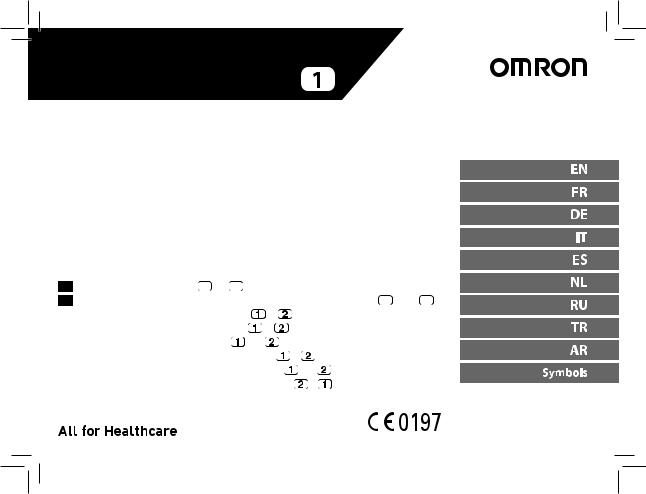
Instruction Manual
Automatic Upper Arm Blood Pressure Monitor
M4 Intelli IT (HEM-7155T-EBK)
X4 Smart (HEM-7155T-ESL)
Read Instruction manual  and
and  before use.
before use.
FR Lire le mode d’emploi  et
et  avant l’utilisation.
avant l’utilisation.
DE Lesen Sie vor der Verwendung die Gebrauchsanweisung  und
und  .
.
|
Leggere il manuale di istruzioni |
e |
prima dell’uso. |
|||
IT |
||||||
|
Lea el manual de instrucciones |
y |
antes del uso. |
|||
ES |
||||||
|
Lees de gebruiksaanwijzing en |
voor gebruik. |
||||
NL |
||||||
|
Прочтите руководство по эксплуатации |
и |
перед использованием. |
|||
RU |
||||||
|
Kullanmadan önce, kullanım kılavuzu |
ve |
'yi okuyun. |
|||
TR |
||||||
|
.مادختسلاا لبق |
و |
تاداشرلإا ليلد أرقا |
|
|
|
|
AR |
|||||
|
|
|||||
Symboles / Symbole / Simboli / Símbolos / Symbolen / Символы / Semboller / زمرلا
19F1483

EN
1.\ Introduction
Thank you for purchasing the OMRON Automatic Upper Arm Blood Pressure Monitor. This blood pressure monitor uses the oscillometric method of blood pressure measurement. This means this monitor detects your blood movement through your brachial artery and converts the movements into a digital reading.
1.1 Safety Instructions
This instruction manual provides you with important information about the OMRON Automatic Upper Arm Blood Pressure Monitor. To ensure the safe and proper use of this monitor, READ and UNDERSTAND all of the safety and operating instructions. If you do
not understand these instructions or have any questions, contact your OMRON retail outlet or distributor before attempting to use this monitor. For specific information about your own blood pressure, consult with your physician.
1.2 Intended Use
This device is a digital monitor intended for use in measuring blood pressure and pulse rate in adult patient population. The device detects the appearance of irregular heartbeats during measurement and gives a warning signal with readings. It is mainly designed for general household use.
1.3 Receiving and Inspection
Remove this monitor from the packaging and inspect for damage. If this monitor is damaged, DO NOT USE and consult with your OMRON retail outlet or distributor.
2.\ Important Safety Information
Read the Important Safety Information in this instruction manual before using this monitor. Follow this instruction manual thoroughly for your safety.
Keep for future reference. For specific information about your own blood pressure, CONSULT WITH YOUR PHYSICIAN.
EN1
Indicates a potentially hazardous 2.1 Warning situation which, if not avoided, could
result in death or serious injury.
•\ DO NOT use this monitor on infants, toddlers, children or persons who cannot express themselves.
•\ DO NOT adjust medication based on readings from this blood pressure monitor. Take medication as prescribed by your physician. ONLY a physician is qualified to diagnose and treat high blood pressure.
•\ DO NOT use this monitor on an injured arm or an arm under medical treatment.
•\ DO NOT apply the arm cuff on your arm while on an intravenous drip or blood transfusion.
•\ DO NOT use this monitor in areas containing high frequency (HF) surgical equipment, magnetic resonance imaging (MRI) equipment, computerized tomography (CT) scanners. This may result in incorrect operation of the monitor and/or cause an inaccurate reading.
•\ DO NOT use this monitor in oxygen rich environments or near flammable gas.
•\ Consult with your physician before using this monitor if you have common arrhythmias such as atrial or ventricular premature beats or atrial fibrillation; arterial sclerosis; poor perfusion; diabetes; pregnancy; pre-eclampsia or renal disease. NOTE that any of these conditions in addition to patient motion, trembling, or shivering may affect the measurement reading.
•\ NEVER diagnose or treat yourself based on your readings. ALWAYS consult with your physician.
•\ To help avoid strangulation, keep the air tube and AC adapter cable away from infants, toddlers and children.
•\ This product contains small parts that may cause a choking hazard if swallowed by infants, toddlers and children.
Data Transmission
•\ This product emits radio frequencies (RF) in the 2.4 GHz band.
DO NOT use this product in locations where RF is restricted, such as on an aircraft or in hospitals. Turn off the Bluetooth® feature in this monitor, remove batteries and/or unplug the AC adapter when in RF restricted areas.

AC Adapter (optional accessory) Handling and Usage
•\ DO NOT use the AC adapter if this monitor or the AC adapter cable is damaged. If this monitor or the cable is damaged, turn off the power and unplug the AC adapter immediately.
•\ Plug the AC adapter into the appropriate voltage outlet. DO NOT use in a multi-outlet plug.
•\ NEVER plug in or unplug the AC adapter from the electric outlet with wet hands.
•\ DO NOT disassemble or attempt to repair the AC adapter.
Battery Handling and Usage
•\ Keep batteries out of the reach of infants, toddlers and children.
Indicates a potentially hazardous situation which, if not avoided,may
2.2 Caution result in minor or moderate injury to the user or patient or damage to the equipment or other property.
•\ Stop using this monitor and consult with your physician if you experience skin irritation or discomfort.
•\ Consult with your physician before using this monitor on an arm where intravascular access or therapy, or an arteriovenous (A-V) shunt, is present because of temporary interference to blood flow and could result in injury.
•\ Consult with your physician before using this monitor if you have had a mastectomy.
•\ Consult with your physician before using this monitor if you have severe blood flow problems or blood disorders as cuff inflation can cause bruising.
•\ DO NOT take measurements more often than necessary because bruising, due to blood flow interference, may occur.
•\ ONLY inflate the arm cuff when it is applied on your upper arm. •\ Remove the arm cuff if it does not start deflating during a
measurement.
•\ DO NOT use this monitor for any purpose other than measuring blood pressure.
•\ During measurement, make sure that no mobile device or any other electrical device that emit electromagnetic fields is within 30 cm of this monitor. This may result in incorrect operation of the monitor and/or cause an inaccurate reading.
•\ DO NOT disassemble or attempt to repair this monitor or other components. This may cause an inaccurate reading.
•\ DO NOT use in a location where there is moisture or a risk of water splashing this monitor. This may damage this monitor.
•\ DO NOT use this monitor in a moving vehicle such as in a car or on an aircraft.
•\ DO NOT drop or subject this monitor to strong shocks or vibrations. •\ DO NOT use this monitor in places with high or low humidity or high
or low temperatures. Refer to section 6.
•\ During measurement, observe the arm to ensure that the monitor is not causing prolonged impairment to blood circulation.
•\ DO NOT use this monitor in high-use environments such as medical clinics or physician offices.
•\ DO NOT use this monitor with other medical electrical (ME) equipment simultaneously. This may result in incorrect operation of the monitor and/or cause an inaccurate reading.
•\ Avoid bathing, drinking alcohol or caffeine, smoking, exercising and eating for at least 30 minutes before taking a measurement.
•\ Rest for at least 5 minutes before taking a measurement.
•\ Remove tight-fitting or thick clothing from your arm while taking a measurement.
•\ Remain still and DO NOT talk while taking a measurement.
•\ ONLY use the arm cuff on persons whose arm circumference is within the specified range of the cuff.
•\ Ensure that this monitor has acclimated to room temperature before taking a measurement. Taking a measurement after an extreme temperature change could lead to an inaccurate reading. OMRON recommends waiting for approximately 2 hours for the monitor to warm up or cool down when the monitor is used in an environment within the temperature specified as operating conditions after
it is stored either at the maximum or at the minimum storage temperature. For additional information on operating and storage/ transport temperature, refer to section 6.
•\ DO NOT use this monitor after the durable period has ended. Refer to section 6.
•\ DO NOT crease the arm cuff or the air tube excessively.
•\ DO NOT fold or kink the air tube while taking a measurement. This may cause an injury by interrupting blood flow.
•\ To unplug the air plug, pull on the plastic air plug at the base of the tube, not the tube itself.
EN
EN2

•\ ONLY use the AC adapter, arm cuff, batteries and accessories specified for this monitor. Use of unsupported AC adapters, arm cuffs and batteries may damage and/or may be hazardous to this monitor.
•\ ONLY use the approved arm cuff for this monitor. Use of other arm cuffs may result in incorrect readings.
•\ Inflating to a higher pressure than necessary may result in bruising of the arm where the cuff is applied. NOTE: refer to “If your systolic pressure is more than 210 mmHg” in section 13 of instruction
manual  for additional information.
for additional information.
•\ Read and follow the “Correct Disposal of This Product” in section 7 when disposing of the device and any used accessories or optional parts.
Data Transmission
•\ DO NOT replace batteries or unplug the AC adapter while your readings are being transferred to your smart device. This may result in incorrect operation of this monitor and failure to transfer your blood pressure data.
AC Adapter (optional accessory) Handling and Usage
•\ Fully insert the AC adapter into the outlet.
•\ When unplugging the AC adapter from the outlet, be sure to safely pull from the AC adapter. DO NOT pull from the AC adapter cable.
•\ When handling the AC adapter cable:
Do not damage it. / Do not break it. / Do not tamper with it.
DO NOT pinch it. / Do not forcibly bend or pull it. / Do not twist it. DO NOT use it if it is gathered in a bundle.
DO NOT place it under heavy objects. •\ Wipe any dust off of the AC adapter.
•\ Unplug the AC adapter when not in use.
•\ Unplug the AC adapter before cleaning this monitor.
Battery Handling and Usage
•\ DO NOT insert batteries with their polarities incorrectly aligned.
•\ ONLY use 4 “AA” alkaline or manganese batteries with this monitor. DO NOT use other types of batteries. DO NOT use new and used batteries together. DO NOT use different brands of batteries together.
•\ Remove batteries if this monitor will not be used for a long period of EN3 time.
•\ If battery fluid should get in your eyes, immediately rinse with plenty of clean water. Consult with your physician immediately.
•\ If battery fluid should get on your skin, wash your skin immediately with plenty of clean, lukewarm water. If irritation, injury or pain persists, consult with your physician.
•\ DO NOT use batteries after their expiration date.
•\ Periodically check batteries to ensure they are in good working condition.
2.3 General Precautions
•\ When you take a measurement on the right arm, the air tube should be at the side of your elbow. Be careful not to rest your arm on the air tube.
•\ Blood pressure may differ between the right and left arm, and may result in a different measurement value. Always use the same arm for measurements. If the values between both arms differ substantially, check with your physician on which arm to use for your measurements.
Remember to have a record of your blood pressure and pulse readings for your physician. A single measurement does not provide an accurate indication of your true blood pressure.
Please use the Blood Pressure Diary to keep records of several readings over a certain period of time. To download PDF files of the diary, visit www.omron-healthcare.com.
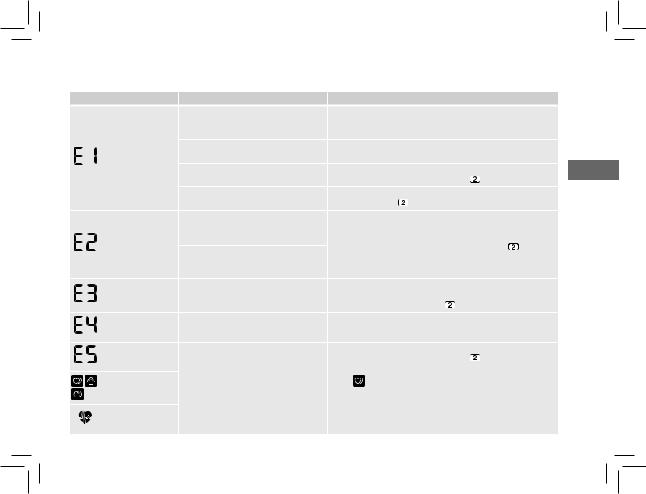
3.\ Error Messages and Troubleshooting
If any of the below problems occur during measurement, check to make sure that no other electrical device is within 30 cm. If the problem persists, please refer to the table below.
Display/Problem |
Possible Cause |
Solution |
|
|
|
The [START/STOP] button was pressed |
Press the [START/STOP] button again to turn the monitor off. |
||
|
while the arm cuff is not applied. |
After inserting the air plug securely and applying the arm cuff |
||
|
|
correctly, press the [START/STOP] button. |
||
appears or the arm |
Air plug is not completely plugged into |
Insert the air plug securely. |
||
the monitor. |
|
|
||
cuff does not inflate. |
|
|
||
The arm cuff is not applied correctly. |
Apply the arm cuff correctly, then take another measurement. |
|||
|
|
Refer to section 7 of instruction manual . |
||
|
Air is leaking from the arm cuff. |
Replace the arm cuff to the new one. Refer to section 14 of |
||
|
|
instruction manual . |
||
appears or a |
You move or talk during a measurement |
Remain still and do not talk during a measurement. If“E2” |
||
and the arm cuff does not inflate |
appears repeatedly, inflate the arm cuff manually until the |
|||
measurement |
||||
sufficiently. |
systolic pressure is 30 to 40 mmHg above your previous |
|||
cannot be |
||||
Due to the systolic pressure is above |
readings. Refer to section 13 of instruction manual . |
|||
completed after the |
||||
|
|
|||
arm cuff inflates. |
210 mmHg, a measurement cannot be |
|
|
|
taken. |
|
|
||
|
|
|
||
|
The arm cuff is inflated exceeding the |
Do not touch the arm cuff and/or bend the air tube while taking |
||
appears |
maximum allowable pressure. |
a measurement. If inflating the arm cuff manually, refer to |
||
|
|
section 13 of instruction manual . |
||
appears |
You move or talk during a measurement. Remain still and do not talk during a measurement. |
|||
Vibrations disrupt a measurement. |
|
|
||
appears |
The pulse rate is not detected correctly. |
Apply the arm cuff correctly, then take another measurement. |
||
|
Refer to section 7 of instruction manual . Remain still and sit |
|||
|
|
correctly during a measurement. |
||
/ appears |
|
If the“ |
” symbol continues to appear, we recommend you to |
|
|
|
consult with your physician. |
||
does not flash during |
|
|
|
|
a measurement. |
|
|
|
|
EN
EN4

Display/Problem |
Possible Cause |
Solution |
appears |
The monitor has malfunctioned. |
Press the [START/STOP] button again. If“Er” still appears, contact |
|
your OMRON retail outlet or distributor. |
|
|
The monior cannot connect to a smart |
Follow the instructions shown in the“OMRON connect” app. |
appears |
device or transmit data correctly. |
If the“Err” symbol still appears after checking the app, contact |
|
your OMRON retail outlet or distributor. |
|
|
|
|
|
The monitor is waiting for pairing with |
Refer to section 5 of instruction manual for pairing your |
flashes |
the smart device. |
monitor with your smart device, or press [START/STOP] button |
|
|
to cancel pairing and turn your monitor off. |
flashes |
The monitor is ready to transfer your |
Open the“OMRON connect” app to transfer your readings. |
readings to the smart device. |
|
|
|
|
|
|
More than 48 readings are not |
Pair or transfer your readings to the“OMRON connect” app so |
flashes |
transferred. |
you can keep them in memory in the app, and this error symbol |
|
The date and time is not set. |
disappears. |
appears |
There are 60 readings in memory to be |
|
transferred |
|
|
|
|
|
flashes |
Batteries are low. |
Replacing all 4 batteries with new ones is recommended. Refer |
|
to section 4 of instruction manual . |
|
|
|
|
appears or the |
Batteries are depleted. |
Immediately replace all 4 batteries with new ones. Refer to |
monitor is turned |
|
section 4 of instruction manual . |
off unexpectedly |
|
|
during a |
|
|
measurement |
|
|
Nothing appears on the |
Battery polarities are not properly |
Check the battery installation for proper placement. Refer to |
display of the monitor. |
||
|
aligned. |
section 4 of instruction manual . |
Readings appear too high or |
Blood pressure varies constantly. Many factors including stress, time of day, and/or how you apply the arm |
|
too low. |
cuff, may affect your blood pressure. Review section 2 of instruction manual . |
|
EN5

Display/Problem |
Possible Cause |
Solution |
Any other communication |
Follow the instructions shown in the smart device, or visit the “Help” section in the “OMRON |
|
issue occurs. |
connect" app for further help. If the problem still persists, contact your OMRON retail outlet or |
|
distributor. |
|
|
|
|
|
|
Press the [START/STOP] button to turn the monitor off, then press it again to take a measurement. |
|
Any other problem occurs. If the problem continues, remove all batteries and wait for 30 seconds. Then re-install batteries. |
||
|
If the problem still persists, contact your OMRON retail outlet or distributor. |
|
4.\ Limited Warranty |
|
|||||||
EN |
||||||||
Thank you for buying an OMRON product. This product is constructed of high quality materials and great care has been taken in its manufacturing. |
||||||||
|
||||||||
It is designed to give you every satisfaction, provided that it is properly operated and maintained as described in the instruction manual. |
|
|||||||
This product is warranted by OMRON for a period of 3 years after the date of purchase. The proper construction, workmanship and materials of |
|
|||||||
this product is warranted by OMRON. During this period of warranty OMRON will, without charge for labour or parts, repair or replace the defect |
|
|||||||
product or any defective parts. |
|
|||||||
The warranty does not cover any of the following: |
|
|||||||
A.\Transport costs and risks of transport. |
|
|||||||
B.\Costs for repairs and / or defects resulting from repairs done by unauthorised persons. |
|
|||||||
C.\Periodic |
check-ups and maintenance. |
|
||||||
D.\Failure |
or wear of optional parts or other attachments other than the main device itself, unless explicitly warranted above. |
|
||||||
E.\ Costs |
arising due to non-acceptance of a claim (those will be charged for). |
|
||||||
F.\ Damages |
of any kind including personal caused accidentally or from misuse. |
|
||||||
G.\Calibration |
service is not included within the warranty. |
|
||||||
H.\Optional |
parts have a one (1) year warranty from date of purchase. Optional parts include, but are not limited to the following items: cuff and |
|
||||||
cuff tube. |
|
|
|
|||||
Should warranty service be required please apply to the dealer whom the product was purchased from or an authorised OMRON distributor. For |
|
|||||||
the address refer to the product packaging / literature or to your specialised retailer. If you have difficulties in finding OMRON customer services, |
|
|||||||
contact us for information: |
|
|||||||
www.omron-healthcare.com |
|
|||||||
Repair or replacement under the warranty does not give rise to any extension or renewal of the warranty period. |
|
|||||||
The warranty will be granted only if the complete product is returned together with the original invoice / cash ticket issued to the consumer by the |
|
|||||||
retailer. |
|
|
|
|
|
|
|
|
EN6

5.\ Maintenance
5.1 Maintenance
To protect your monitor from damage, follow the directions below:
Changes or modifications not approved by the manufacturer will void the user warranty.

 Caution
Caution
DO NOT disassemble or attempt to repair this monitor or other components. This may cause an inaccurate reading.\
5.2 Storage
•\ Keep your monitor in the storage case when not in use.
1.\Remove the arm cuff from the monitor.

 Caution
Caution
To unplug the air plug, pull on the plastic air plug at the base of the tube, not the tube itself.\
2.\Gently fold the air tube into the arm cuff. Note: Do not bend or crease the air tube excessively. 3.\Place your monitor and other components in the storage case.
•\ Store your monitor and other components in a clean, safe location. •\ Do not store your monitor and other components:
•\If your monitor and other components are wet.
•\In locations exposed to extreme temperatures, humidity, direct sunlight, dust or corrosive vapors such as bleach. •\In locations exposed to vibrations or shocks.
5.3 Cleaning
•\ Do not use any abrasive or volatile cleaners.
•\ Use a soft dry cloth or a soft cloth moistened with mild (neutral) detergent to clean your monitor and arm cuff, and then wipe them with a dry cloth.
•\ Do not wash or immerse your monitor and arm cuff or other components in water.
•\ Do not use gasoline, thinners or similar solvents to clean your monitor and arm cuff or other components.
5.4 Calibration and Service
•\ The accuracy of this blood pressure monitor has been carefully tested and is designed for a long service life.
•\ It is generally recommended to have the unit inspected every two years to ensure correct functioning and accuracy. Please consult your authorised OMRON dealer or the OMRON Customer Service at the address given on the packaging or attached literature.
EN7

6.\ Specifications
Product description |
Automatic Upper Arm Blood Pressure Monitor |
|
|
Product category |
Electronic Sphygmomanometers |
|
|
Model (code) |
M4 Intelli IT (HEM-7155T-EBK) |
Display |
LCD digital display |
|
X4 Smart (HEM-7155T-ESL) |
|
|
Cuff pressure range |
0 to 299 mmHg |
Pulse measurement range 40 to 180 beats / min. |
|
Blood pressure measurement range |
SYS: 60 to 260 mmHg / DIA: 40 to 215 mmHg |
|
|
Accuracy |
Pressure: ±3 mmHg / Pulse: ±5% of display reading |
|
|
Inflation |
Automatic by electric pump |
Deflation |
Automatic pressure release valve |
Measurement method |
Oscillometric method |
Transmission method |
Bluetooth® Low Energy |
Wireless communication |
Frequency range: 2.4 GHz (2400 - 2483.5 MHz) / Modulation: GFSK |
||
|
Effective radiated power: < 20 dBm |
|
|
Operating mode |
Continuous operation |
|
|
IP classification |
Monitor: IP20 / Optional AC adapter: IP21 |
|
|
Rating |
DC6 V 4.0 W |
Applied part |
Type BF (arm cuff) |
Power source |
4 “AA” batteries 1.5 V or optional AC adapter (INPUT AC 100 - 240 V 50 - 60 Hz 0.12 - 0.065 A) |
||
Battery life |
Approximately 1000 measurements (using new alkaline batteries) |
||
Durable period (Service life) |
Monitor: 5 years / Cuff: 5 years / Optional AC adapter: 5 years |
||
Operating conditions |
+10 to +40 °C / 15 to 90% RH (non-condensing) / 800 to 1060 hPa |
||
Storage / Transport conditions |
-20 to +60 °C / 10 to 90% RH (non-condensing) |
|
|
Contents |
Monitor, arm cuff (HEM-FL31), 4 “AA” batteries, storage case, Instruction Manual and |
||
|
, setup instructions |
|
|
Protection against electric shock |
Internally powered ME equipment (when using only batteries) |
||
|
Class II ME equipment (optional AC adapter) |
|
|
Weight |
Monitor: approximately 340 g (not including batteries) / Arm cuff: approximately 163 g |
||
Dimensions (approximately value) |
Monitor: 105 mm (W) × 85 mm (H) × 152 mm (L) |
|
|
|
Arm cuff: 145 mm × 532 mm (air tube: 750 mm) |
|
|
Memory |
Stores up to 60 readings per user |
|
|
EN
EN8

Note
•\ These specifications are subject to change without notice.
•\ This monitor is clinically investigated according to the requirements of ISO 81060-2:2013. In the clinical validation study, K5 was used on 85 subjects for determination of diastolic blood pressure.
•\ This device has been validated for use on pregnant and pre-eclampsia patients according to the Modified European Society of Hypertension Protocol*.
•\ This device has been validated for use on diabetic (Type II) population**.
•\ IP classification is degrees of protection provided by enclosures in accordance with IEC 60529. This monitor and optional AC adapter are protected against solid foreign objects of 12.5 mm diameter and greater such as a finger. The optional AC adapter is protected against vertically falling water drops which may cause issues during a normal operation.
*Topouchian J et al. Vascular Health and Risk Management 2018:14 189–197
**Chahine M.N. et al. Medical Devices: Evidence and Research 2018:11 11–20
About a wireless communication interference
This product operates in an unlicensed ISM band at 2.4 GHz. In the event this product is used near other wireless devices such as microwave and wireless LAN, which operate on the same frequency band as this product, there is a possibility that interference may occur. If interference occurs, stop the operation of the other devices or relocate this product away from other wireless devices before attempting to use it.
7.\ Correct Disposal of This Product (Waste Electrical & Electronic Equipment)
This marking shown on the product or its literature, indicates that it should not be disposed of, with other household wastes at the end of its working life.
To prevent possible harm to the environment or human health from uncontrolled waste disposal, please separate this product from other types of wastes and recycle it responsibly to promote the sustainable reuse of material resources.
Household users should contact either the retailer where they purchased this product, or their local government office, for details of where and how they can return this item for environmentally safe recycling.
Business users should contact their supplier and check the terms and conditions of the purchase contract. This product should not be mixed with other commercial waste for disposal.
8.\ Important Information Regarding Electromagnetic Compatibility (EMC)
HEM-7155T-EBK and HEM-7155T-ESL conform to EN60601 1 2:2015 Electromagnetic Compatibility (EMC) standard. Further documentation in accordance with this EMC standard is available at
www.omron-healthcare.com
Refer to the EMC information for HEM-7155T-EBK and HEM-7155T-ESL on the website.
EN9

9.\ Guidance and Manufacturer’s Declaration
•\ This blood pressure monitor is designed according to the European Standard EN1060, Non-invasive sphygmomanometers Part 1: General Requirements and Part 3: Supplementary requirements for electromechanical blood pressure measuring systems.
•\ Hereby, OMRON HEALTHCARE Co., Ltd., declares that the radio equipments type HEM-7155T-EBK and HEM-7155T-ESL are complied with Directive 2014/53/EU. The full text of the EU declaration of conformity is available at the following internet address: www.omron-healthcare.com
•\ This OMRON product is produced under the strict quality system of OMRON HEALTHCARE Co., Ltd., Japan. The Core component for OMRON blood pressure monitors, which is the Pressure Sensor, is produced in Japan.
•\ Please report to the manufacturer and the competent authority of the Member State in which you are established about any serious incident that has occurred in relation to this device.
EN
EN10

FR
1.\ Introduction
Merci d’avoir fait l’acquisition du tensiomètre brassard OMRON automatique. Ce tensiomètre fonctionne sur le principe de l’oscillométrie pour mesurer votre pression artérielle. Cela signifie qu’il détecte la circulation de votre sang dans l’artère brachiale et la convertit en une mesure numérique.
1.1 Instructions de sécurité
Ce mode d’emploi vous fournit des informations importantes sur le tensiomètre brassard automatique OMRON. Pour une utilisation sûre et correcte de ce tensiomètre, LIRE et COMPRENDRE toutes les
instructions de sécurité et de fonctionnement. Si vous ne comprenez pas ces instructions ou avez des questions, contactez votre détaillant ou votre revendeur OMRON avant d’essayer d’utiliser ce tensiomètre. Pour des informations spécifiques sur votre propre pression artérielle, consultez votre médecin.
1.2 Utilisation prévue
Ce tensiomètre numérique est conçu pour mesurer la pression artérielle et le pouls chez les patients adultes. L’appareil détecte les pulsations cardiaques irrégulières pendant la mesure et émet un signal d’avertissement. Il a été conçu essentiellement pour une utilisation générale à domicile.
1.3 Réception et inspection
Retirer ce tensiomètre de son emballage et vérifier qu’il n’est pas endommagé. S’il est endommagé, NE PAS L’UTILISER et consulter votre détaillant ou votre revendeur OMRON.
2.\ Informations importantes sur la sécurité
Lire les informations importantes sur la sécurité dans le présent mode d’emploi avant d’utiliser ce tensiomètre. Suivre attentivement le présent mode d’emploi pour votre sécurité.
Le conserver pour s’y référer ultérieurement. Pour des informations spécifiques sur votre propre pression artérielle, CONSULTER VOTRE MÉDECIN.
FR1
Indique une situation potentiellement dangereuse
2.1 Avertissement qui, si elle n’est pas évitée, peut entraîner la mort ou de graves lésions.
•\ NE PAS utiliser ce tensiomètre sur des nourrissons, des tout-petits, des enfants ou des personnes qui ne peuvent pas s’exprimer.
•\ NE PAS modifier le traitement sur la base des mesures réalisées à l’aide de ce tensiomètre. Suivre le traitement prescrit par votre médecin. SEUL un médecin est qualifié pour diagnostiquer et traiter l’hypertension.
•\ NE PAS utiliser ce tensiomètre sur un bras blessé ou placé sous traitement médical.
•\ NE PAS porter le brassard sur le bras dans lequel une perfusion ou une transfusion de sang est en cours.
•\ NE PAS utiliser ce tensiomètre dans des lieux contenant des équipements chirurgicaux à haute fréquence (HF), d’imagerie par résonance magnétique (IRM) ou de tomodensitométrie (CT). Cela risquerait de perturber le fonctionnement du moniteur et/ou de provoquer des erreurs de mesure.
•\ NE PAS utiliser ce tensiomètre dans des environnements riches en oxygène ou à proximité de gaz inflammables.
•\ Consulter votre médecin avant d’utiliser ce tensiomètre dans l’une des conditions suivantes : arythmies courantes telles qu’extrasystoles auriculaires ou ventriculaires ; fibrillation auriculaire ; artériosclérose ; mauvaise perfusion ; diabète ; grossesse ; pré-éclampsie ou maladie rénale. NOTEZ que toutes ces conditions, en plus des mouvements, tremblements ou frissons du patient peuvent avoir un impact sur la mesure.
•\ Ne JAMAIS poser un diagnostic ou vous traiter vous-même sur la base des mesures réalisées. TOUJOURS consulter un médecin.
•\ Pour éviter tout risque de strangulation, conserver le tuyau à air et le câble de l’adaptateur secteur hors de portée des bébés et des enfants.
•\ Ce produit contient des petites pièces pouvant présenter un risque d’étouffement en cas d’ingestion par des bébés et des enfants.
Transmission des données
•\ Ce produit émet des radiofréquences (RF) sur la bande 2,4 GHz. NE PAS l’utiliser dans des endroits avec restrictions de RF, comme dans un avion ou dans les hôpitaux. Désactiver la fonction Bluetooth® de ce tensiomètre, retirer les piles et/ou débrancher l’adaptateur secteur dans les endroits avec restrictions de RF.

Manipulation et utilisation de l’adaptateur secteur (accessoire en option)
•\ NE PAS utiliser l’adaptateur secteur si le tensiomètre ou le câble de l’adaptateur secteur est endommagé. Si le tensiomètre ou le
câble de l’adaptateur secteur est endommagé, éteindre l’appareil et débrancher l’adaptateur secteur immédiatement.
•\ Brancher l’adaptateur secteur sur la prise de tension appropriée. NE PAS utiliser avec une multiprise.
•\ NE JAMAIS brancher ou débrancher l’adaptateur secteur de la prise électrique avec les mains mouillées.
•\ NE PAS démonter ou tenter de réparer l’adaptateur secteur.
Manipulation et utilisation de la pile
•\ Garder les piles hors de la portée des bébés et des enfants.
Indique une situation potentiellement
dangereuse qui, si elle n’est pas évitée, 2.2 Attention peut entraîner des blessures mineures ou
modérées chez l’utilisateur ou le patient, ou endommager l’appareil ou autre équipement.
•\ Arrêter d’utiliser ce tensiomètre et consulter votre médecin en cas d’irritation cutanée ou de gêne.
•\ Consulter votre médecin avant d’utiliser ce tensiomètre sur un bras muni d’une perfusion intravasculaire ou sous traitement intravasculaire, ou pourvu d’une anastomose artérioveineuse en raison d’interférences temporaires avec le flux sanguin et du risque de blessure.
•\ Si vous avez subi une mastectomie, consulter votre médecin avant d’utiliser ce tensiomètre.
•\ Consulter votre médecin avant d’utiliser ce tensiomètre si vous êtes atteint de graves problèmes de circulation sanguine ou de troubles sanguins car le gonflage du brassard peut causer des ecchymoses.
•\ NE PAS effectuer de mesures plus souvent que nécessaire car cela peut provoquer des ecchymoses consécutives aux interférences avec le flux sanguin.
•\ NE gonfler le brassard QUE lorsqu’il enroulé autour de votre bras.
•\ Retirer le brassard s’il ne commence pas à se dégonfler lors d’une mesure. •\ NE PAS utiliser ce tensiomètre dans d’autres buts que la mesure de
la pression artérielle.
•\ Pendant la mesure, veiller à ce qu’aucun appareil mobile ou autre appareil électrique émettant des champs électromagnétiques ne se
trouve dans un rayon de 30 cm de ce moniteur. Cela risquerait de perturber le fonctionnement du moniteur et/ou de provoquer des erreurs de mesure.
•\ NE PAS démonter ou tenter de réparer le tensiomètre ou d’autres composants. Cela pourrait compromettre la précision de lecture.
•\ NE PAS utiliser le tensiomètre dans un endroit humide ou dans lequel il pourrait être éclaboussé par de l’eau. Cela risque de l’endommager.
•\ NE PAS utiliser ce tensiomètre dans un véhicule en mouvement, comme une voiture ou un avion.
•\ NE PAS laisser tomber le tensiomètre ou le soumettre à des vibrations ou chocs violents.
•\ NE PAS utiliser ce tensiomètre dans des endroits présentant une humidité élevée ou faible, ou des températures élevées ou basses. Se reporter à la section 6.
•\ Pendant la mesure, observer le bras pour vérifier que le tensiomètre ne provoque pas une altération prolongée de la circulation sanguine.
•\ NE PAS utiliser ce tensiomètre dans des environnements à forte utilisation, tels que les cliniques médicales ou les cabinets de médecins.
•\ NE PAS utiliser ce tensiomètre en même temps qu’un autre équipement médical électrique. Cela risquerait de perturber le fonctionnement du moniteur et/ou de provoquer des erreurs de mesure.
•\ Éviter de prendre un bain, de consommer de l’alcool ou de la caféine, de fumer ou de faire du sport 30 minutes avant la mesure.
•\ Se reposer pendant au moins 5 minutes avant la mesure.
•\ Retirer les vêtements moulants ou épais de votre bras lorsque vous effectuez une mesure.
•\ Rester immobile et NE PAS parler pendant la mesure.
•\ N’utiliser le brassard QUE sur des personnes dont la circonférence du bras se situe dans la plage spécifiée du brassard.
•\ Veillez à ce que le tensiomètre ait atteint la température ambiante avant d’effectuer une mesure. Toute mesure réalisée après un changement de température extrême pourrait fournir un résultat incorrect. OMRON recommande d’attendre environ 2 heures pour que le tensiomètre se réchauffe ou se refroidisse lorsqu’il est utilisé dans un environnement dont la température se situe dans la plage des températures indiquées comme températures de fonctionnement, après qu’il a été conservé à la température de stockage maximum
ou minimum. Pour plus d’informations sur les températures de fonctionnement et de stockage/transport, se reporter à la section 6.
FR
FR2

•\ NE PAS utiliser ce tensiomètre après expiration de sa durée de vie. Se reporter à la section 6.
•\ NE PAS tordre le brassard et ne pas plier excessivement le tuyau à air. •\ NE PAS plier ou couder le tuyau à air pendant la réalisation d’une mesure.
Cela pourrait provoquer des lésions par interruption du flux sanguin. •\ Pour débrancher la prise de gonflage, tirer la prise de gonflage en
plastique à la base du tuyau, et non le tuyau lui-même.
•\ N’utiliser QUE l’adaptateur secteur, le brassard, les piles et les accessoires spécifiés pour ce tensiomètre. L’utilisation d’adaptateurs secteur, brassards et piles inappropriés peut s’avérer dangereuse pour le moniteur et/ou l’endommager.
•\ Utiliser UNIQUEMENT le brassard approuvé pour ce tensiomètre. L’utilisation d’autres brassards peut fausser les résultats des mesures.
•\ Le gonflage du brassard à une pression plus élevée que nécessaire peut provoquer des ecchymoses sur le bras à l’endroit où le brassard est posé. REMARQUE : se reporter à l’encadré « Si votre pression systolique est supérieure à 210 mmHg » de la section 13 du mode
d’emploi  pour plus d’informations.
pour plus d’informations.
•\ Lire et suivre la procédure de « Mise au rebut correcte de ce produit » de la section 7 pour la mise au rebut de l’appareil et des accessoires ou pièces optionnelles utilisés.
Transmission des données
•\ NE PAS remplacer les piles ou débrancher l’adaptateur secteur pendant le transfert de vos mesures sur votre appareil intelligent. Cela risquerait de perturber le fonctionnement du tensiomètre et d’entraîner l’échec du transfert de vos données de pression artérielle.
Manipulation et utilisation de l’adaptateur secteur (accessoire en option)
•\ Insérer entièrement l’adaptateur secteur dans la prise.
•\ Pour débrancher l’adaptateur secteur de la prise, tirer délicatement l’adaptateur secteur. NE PAS tirer sur le câble de l’adaptateur secteur.
•\ Lors de la manipulation du câble de l’adaptateur secteur : ne pas l’endommager. / Ne pas le casser. / Ne pas le modifier.
NE PAS le pincer. / Ne pas le plier ou le tirer avec force. / Ne pas le tordre. NE PAS l’utiliser s’il est entortillé.
NE PAS le placer sous des objets lourds. •\ Dépoussiérer l’adaptateur secteur.
•\ Débrancher l’adaptateur secteur lorsqu’il n’est pas utilisé.
FR3
•\ Débrancher l’adaptateur secteur avant de nettoyer le tensiomètre.
Manipulation et utilisation de la pile
•\ NE PAS introduire les piles en inversant leur polarité.
•\ Utiliser UNIQUEMENT 4 piles alcalines ou au manganèse « AA » avec ce tensiomètre. NE PAS utiliser d’autres types de piles. NE PAS utiliser des piles neuves et usagées en même temps. NE PAS utiliser des piles de marques différentes en même temps.
•\ Retirer les piles si le tensiomètre ne doit pas être utilisé pendant une longue période.
•\ En cas de projection du liquide provenant des piles dans les yeux, rincer immédiatement et abondamment à l’eau. Consulter immédiatement votre médecin.
•\ En cas de projection du liquide provenant des piles sur votre peau, la laver immédiatement et abondamment à l’eau tiède. En cas d’irritation, de blessure ou de douleur persistante, consulter votre médecin.
•\ NE PAS utiliser de piles après leur date d’expiration.
•\ Vérifier régulièrement les piles pour vous assurer qu’elles sont en bon état.
2.3 Précautions générales
•\ Lorsque la mesure est effectuée sur le bras droit, le tuyau à air doit se trouver à côté de votre coude. Veiller à ne pas poser le bras sur le tuyau à air.
•\ La pression artérielle peut être différente entre le bras droit et le bras gauche. Les résultats de la mesure peuvent donc être différents. Toujours utiliser le même bras pour les mesures. Si les valeurs mesurées aux deux bras sont trop différentes, consulter votre médecin pour savoir quel bras utiliser pour les mesures.
Ne pas oublier d’enregistrer toutes vos mesures de pression artérielle et de pouls pour votre médecin. Une seule mesure ne donne pas une indication précise de votre pression artérielle réelle.
Utiliser le journal de pression artérielle pour enregistrer plusieurs résultats sur une période de temps donnée. Les fichiers PDF du journal sont disponibles sur www.omron-healthcare.com.
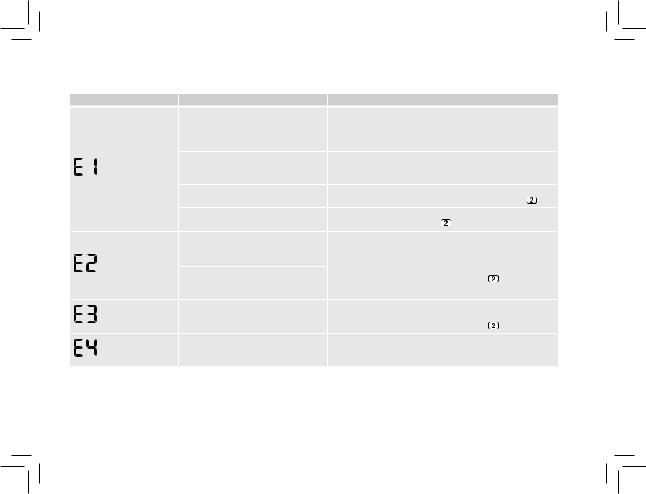
3.\ Messages d’erreur et dépannage
Si l’un des problèmes ci-dessous se produit pendant la mesure, vérifier qu’aucun autre appareil électrique ne se trouve à moins de 30 cm. Si le problème persiste, se reporter au tableau ci-dessous.
Affichage/Problème |
Cause possible |
Solution |
|
|
Le bouton [START/STOP] a été utilisé |
Appuyer une nouvelle fois sur le bouton [START/STOP] |
|
|
alors que le brassard n’est pas en place. pour éteindre le tensiomètre. Après avoir inséré la prise de |
|
|
|
|
gonflage fermement et avoir posé le brassard correctement, |
|
|
|
appuyer sur le bouton [START/STOP]. |
|
s’affiche ou le |
La prise de gonflage n’est pas |
Brancher la prise de gonflage fermement. |
|
brassard ne se |
entièrement insérée dans le |
|
|
gonfle pas. |
tensiomètre. |
|
|
|
Le brassard n’est pas correctement |
Poser le brassard correctement, puis effectuer une nouvelle |
FR |
|
posé. |
mesure. Se reporter à la section 7 du mode d’emploi . |
|
|
Le brassard laisse échapper de l’air. |
Remplacer le brassard par un brassard neuf. Se reporter à la |
|
|
|
section 14 du mode d’emploi . |
|
s’affiche ou il |
Vous bougez ou parlez pendant une |
Rester immobile et ne pas parler pendant la mesure. Si |
|
est impossible |
mesure et le brassard ne se gonfle pas |
« E2 » apparaît à plusieurs reprises, gonfler le brassard |
|
d’effectuer une |
suffisamment. |
manuellement jusqu’à ce que la pression systolique soit |
|
mesure après que |
La pression systolique étant supérieure |
de 30 à 40 mmHg supérieure aux résultats précédents. Se |
|
le brassard s’est |
à 210 mmHg, il est impossible de |
reporter à la section 13 du mode d’emploi . |
|
gonflé. |
réaliser une mesure. |
|
|
|
Le brassard a été gonflé au-delà de la |
Ne pas toucher le brassard et/ou plier le tuyau à air pendant |
|
s’affiche |
pression maximale admissible. |
une mesure. Pour gonfler le brassard manuellement, se |
|
|
|
reporter à la section 13 du mode d’emploi . |
|
|
Vous bougez ou parlez pendant la |
Rester immobile et ne pas parler pendant la mesure. |
|
s’affiche |
mesure. Les vibrations perturbent la |
|
|
|
mesure. |
|
|
FR4
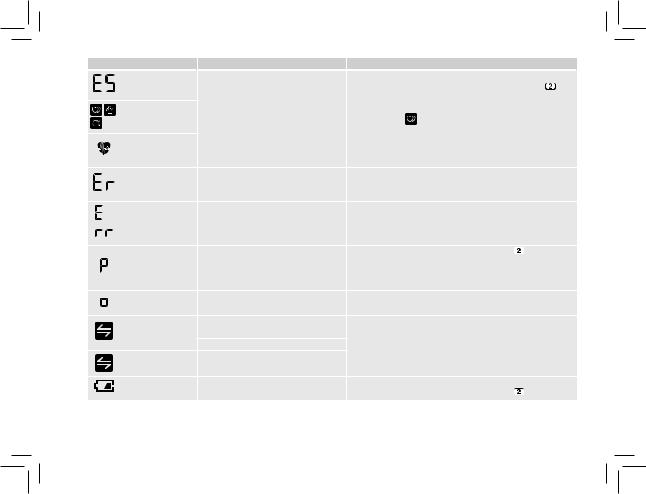
Affichage/Problème |
Cause possible |
Solution |
|
|
|
s’affiche |
Le pouls n’est pas détecté |
Poser le brassard correctement, puis effectuer une nouvelle |
|||
correctement. |
mesure. Se reporter à la section 7 du mode d’emploi |
||||
|
|
. Rester immobile et s’asseoir correctement pendant la |
|||
/ / s’affiche |
|
mesure. |
|
|
|
|
Si le symbole « |
» continue à s’afficher, nous vous |
|||
ne clignote pas |
|
recommandons de consulter votre médecin. |
|
||
|
|
|
|
||
pendant une |
|
|
|
|
|
mesure |
|
|
|
|
|
|
Le tensiomètre a mal fonctionné. |
Appuyer à nouveau sur le bouton [START/STOP]. Si « Er » |
|||
s’affiche |
|
continue à s’afficher, contacter votre détaillant ou votre |
|||
|
|
revendeur OMRON. |
|
||
|
Le tensiomètre n’arrive pas à se |
Suivre les indications fournies dans l’application « OMRON |
|||
s’affiche |
connecter à un appareil intelligent |
connect ». Si le symbole « Err » s’affiche encore après la |
|||
ou à transmettre les données |
vérification de l’application, contacter votre détaillant ou |
||||
|
|||||
|
correctement. |
votre revendeur OMRON. |
|
||
|
Le tensiomètre est en attente de |
Se reporter à la section 5 du mode d’emploi |
pour |
||
clignote |
jumelage avec l’appareil intelligent. |
le jumelage de votre tensiomètre avec votre appareil |
|||
|
intelligent, ou appuyer sur le bouton [START/STOP] pour |
||||
|
|
||||
|
|
annuler le jumelage et éteindre votre tensiomètre. |
|||
clignote |
Le tensiomètre est prêt à transmettre |
Ouvrir l’application « OMRON connect » pour transférer vos |
|||
vos résultats à l’appareil intelligent. |
mesures. |
|
|
||
|
|
|
|||
|
Plus de 48 mesures ne sont pas |
Jumeler avec l’application « OMRON connect » ou transférer |
|||
clignote |
transférées. |
vos mesures dans l’application pour pouvoir les conserver |
|||
|
La date et l’heure ne sont pas définies. |
en mémoire dans l’application. Ce symbole d’erreur |
|||
s’affiche |
La mémoire contient 60 résultats à |
disparaîtra. |
|
|
|
|
|
|
|||
transférer |
|
|
|
||
|
|
|
|
||
clignote |
Les piles sont faibles. |
Il est recommandé de remplacer les 4 piles par des neuves. |
|||
|
Se reporter à la section 4 du mode d’emploi . |
|
|||
|
|
|
|||
FR5

Affichage/Problème |
Cause possible |
Solution |
|
|
|
|
|
|
|
|||
|
s’affiche ou le |
Les piles sont épuisées. |
Remplacer immédiatement les 4 piles par des piles neuves. |
|
|
|
|
|
|
|
||
|
tensiomètre s’éteint |
|
Se reporter à la section 4 du mode d’emploi . |
|
|
|
|
|
|
|
||
|
accidentellement |
|
|
|
|
|
|
|
|
|
||
|
pendant une |
|
|
|
|
|
|
|
|
|
||
|
mesure |
|
|
|
|
|
|
|
|
|
||
Rien ne s’affiche sur l’écran |
Les polarités des piles ne sont pas |
Vérifier que les piles sont correctement installées. Se |
|
|
|
|
|
|
|
|||
du tensiomètre. |
|
|
|
|
|
|
|
|||||
|
|
|
|
correctement alignées. |
reporter à la section 4 du mode d’emploi . |
|
|
|
|
|
|
|
Les résultats semblent trop |
La pression artérielle varie constamment. De nombreux facteurs, y compris le stress, l’heure de la |
|
|
|
|
|
|
|
||||
journée et/ou la façon dont vous posez le brassard, peuvent avoir une incidence sur votre pression |
|
FR |
|
|
|
|||||||
hauts ou trop bas. |
|
|
|
|
||||||||
artérielle. Se reporter à la section 2 du mode d’emploi . |
|
|
|
|
||||||||
Un autre problème de |
Suivre les instructions affichées sur l’appareil intelligent ou consulter la section « Aide » de |
|
|
|
|
|
|
|
||||
l’application « OMRON connect » pour obtenir de l’aide. Si le problème persiste, contacter votre |
|
|
|
|
|
|
|
|||||
communication se produit. |
|
|
|
|
|
|
|
|||||
|
|
|
|
détaillant ou votre revendeur OMRON. |
|
|
|
|
|
|
|
|
|
|
|
|
Appuyer sur le bouton [START/STOP] pour arrêter le tensiomètre, puis une nouvelle fois pour |
|
|
|
|
|
|
|
|
Un autre problème se |
effectuer une mesure. Si le problème persiste, retirer toutes les piles et atteindre 30 secondes. |
|
|
|
|
|
|
|
||||
produit. |
|
|
Réinstaller ensuite les piles. |
|
|
|
|
|
|
|
|
|
|
|
|
|
Si le problème persiste, contacter votre détaillant ou votre revendeur OMRON. |
|
|
|
|
|
|
|
|
4.\ Garantie limitée |
|
|
|
|
|
|
|
|
|
|||
Merci d’avoir acheté un produit OMRON. Ce produit est fabriqué à l’aide de matériaux de haute qualité et les plus grands soins ont été apportés |
|
|
|
|
|
|
|
|||||
à sa fabrication. Il est conçu pour vous apporter toute satisfaction, à condition de l’utiliser et de l’entretenir correctement, conformément aux |
|
|
|
|
|
|
|
|||||
indications du mode d’emploi. |
|
|
|
|
|
|
|
|
|
|||
Ce produit est garanti par OMRON pour une période de 3 ans après la date d’achat. La qualité de la fabrication, de la main d’œuvre et des matériaux |
|
|
|
|
|
|
|
|||||
est garantie par OMRON. Pendant cette période de garantie, OMRON réparera ou remplacera le produit défectueux ou tout pièce défectueuse sans |
|
|
|
|
|
|
|
|||||
facturer la main d’œuvre ni les pièces. |
|
|
|
|
|
|
|
|
||||
La garantie ne couvre aucun des éléments suivants : |
|
|
|
|
|
|
|
|
||||
A.\Frais et risques liés au transport. |
|
|
|
|
|
|
|
|
||||
B.\Coûts des réparations et/ou des défauts résultant de réparations effectuées par des personnes non agréées. |
|
|
|
|
|
|
|
|||||
C.\Contrôles |
et maintenance périodiques. |
|
|
|
|
|
|
|
|
|||
D.\Panne |
ou usure de pièces optionnelles ou autres accessoires autres que l’unité principale même, sauf garantie expresse ci-dessus. |
|
|
|
|
|
|
|
||||
E.\ Coûts |
résultant de la non-acceptation d’une réclamation (ces coûts seront facturés). |
|
|
|
|
|
|
|
||||
F.\ Dommages |
quelconques, y compris dommages personnels d’origine accidentelle ou résultant d’une utilisation inappropriée. |
FR6 |
|
|
|
|||||||
|
|
|
|
|
|
|
|
|
||||
|
|
|
|
|
|
|
|
|
|
|
|
|
|
|
|
|
|
|
|
|
|
|
|
|
|
|
|
|
|
|
|
|
|
|
|
|
|
|
|
|
|
|
|
|
|
|
|
|
|
|
|

G.\Le service d’étalonnage n’est pas inclus dans la garantie.
H.\Les pièces optionnelles ont une garantie de un (1) an à partir de la date d’achat. Les pièces optionnelles comprennent, sans y être limitées, les éléments suivants : brassard et tuyau du brassard.
Si un entretien au titre de la garantie est requis, s’adresser au détaillant chez lequel le produit a été acheté ou à un revendeur OMRON agréé. Pour les adresses, se référer à l’emballage/à la documentation du produit ou à votre détaillant spécialisé. En cas de difficultés pour trouver les services clientèle d’OMRON, nous contacter pour information :
www.omron-healthcare.com
La réparation ou le remplacement sous garantie ne donne pas droit à une extension ou à un renouvellement de la période de garantie.
La garantie ne s’applique que si le produit complet est retourné, accompagné de la facture/du ticket de caisse d’origine établi(e) au nom du consommateur par le détaillant.
5.\ Maintenance
5.1 Maintenance
Pour protéger votre tensiomètre contre des dommages éventuels, procéder comme suit : Toute modification non autorisée par le fabricant annulera la garantie utilisateur.

 Attention
Attention
NE PAS démonter ou tenter de réparer le tensiomètre ou d’autres composants. Cela pourrait compromettre la précision de lecture.\
5.2 Stockage
•\ Conserver le tensiomètre dans son étui de rangement lorsqu’il n’est pas utilisé.
1.\Retirer le brassard du tensiomètre.

 Attention
Attention
Pour débrancher la prise de gonflage, tirer la prise de gonflage en plastique à la base du tuyau, et non le tuyau lui-même.\
2.\Plier délicatement le tuyau à air dans le brassard. Remarque : ne pas plier ou tordre excessivement le tuyau à air. 3.\Placer le tensiomètre et les autres composants dans l’étui de rangement.
•\ Conserver votre tensiomètre et ses composants dans un endroit propre et sûr. •\ Ne pas stocker votre tensiomètre et les autres composants :
•\Si votre tensiomètre et les autres composants sont mouillés.
•\Dans des endroits soumis à des températures extrêmes, à l’humidité, à la lumière directe du soleil, à la poussière ou à des vapeurs corrosives telles que l’eau de Javel.
•\Dans des endroits exposés à des vibrations ou à des chocs.
FR7

5.3 Nettoyage
•\ Ne pas utiliser de produits nettoyants abrasifs ou volatils.
•\ Utiliser un chiffon doux et sec ou un chiffon doux imprégné de détergent doux (neutre) pour nettoyer votre tensiomètre et le brassard, puis les sécher à l’aide d’un chiffon sec.
•\ Ne pas laver ou immerger votre tensiomètre et le brassard ou les autres composants dans l’eau.
•\ Ne pas utiliser d’essence, de diluant ou autre solvant pour nettoyer votre tensiomètre, le brassard et les autres composants.
5.4 Étalonnage et entretien
•\ Des tests rigoureux ont été réalisés afin de garantir la précision de ce tensiomètre et de lui assurer une longue durée de vie.
•\ Il est généralement recommandé de faire inspecter l’appareil tous les deux ans afin de garantir son bon fonctionnement et sa précision. Veuillez contacter votre revendeur OMRON agréé ou le service clientèle d’OMRON à l’adresse indiquée sur l’emballage ou dans la documentation fournie.
6.\ Spécifications
Description du produit |
Tensiomètre automatique brassard |
|
FR |
|
|
|
|||
Catégorie de produit |
Sphygmomanomètres électroniques |
|
|
|
|
|
|
|
|
Modèle (réf.) |
M4 Intelli IT (HEM-7155T-EBK) |
Affichage |
Affichage numérique LCD |
|
|
|
|||
|
X4 Smart (HEM-7155T-ESL) |
|
|
|
|
|
|
|
|
Plage de pressions du brassard |
0 à 299 mmHg |
Plage de mesure du pouls 40 à 180 pulsations/min. |
|
|
|
||||
Plage de mesure de la pression |
SYS : 60 à 260 mmHg / DIA : 40 à 215 mmHg |
|
|
|
|
|
|
|
|
artérielle |
|
|
|
|
|
|
|
|
|
Précision |
Pression : ±3 mmHg / Pouls : ±5 % de la lecture de l’affichage |
|
|
|
|||||
Gonflage |
Automatique par une pompe |
Dégonflage |
Soupape de régulation |
|
|
|
|||
|
électrique |
|
automatique de la pression |
|
|
|
|||
Méthode de mesure |
Méthode oscillométrique |
Méthode de transmission Bluetooth® Low Energy |
|
|
|
||||
Communication sans fil |
Plage de fréquences : 2,4 GHz (2400 - 2483,5 MHz) / Modulation : GFSK |
|
|
|
|||||
|
Puissance rayonnée efficace : <20 dBm |
|
|
|
|
|
|
|
|
Mode de fonctionnement |
Fonctionnement continu |
|
|
|
|
|
|
|
|
Classification IP |
Tensiomètre : IP20 / Adaptateur secteur en option : IP21 |
|
|
|
|
|
|
|
|
Valeur nominale |
6 V c.c. 4,0 W |
Pièce appliquée |
Type BF (brassard) |
|
|
|
|||
Source d’alimentation |
4 piles « AA » 1,5 V ou adaptateur secteur en option (ENTRÉE CA 100 - 240 V 50 - 60 Hz |
|
|
|
|||||
|
0,12 - 0,065 A) |
|
|
|
|
|
|
|
|
Durée de vie des piles |
Environ 1000 mesures (avec piles alcalines neuves) |
|
|
|
|
|
|
|
|
Durée de vie |
Tensiomètre : 5 ans / Brassard : 5 ans / Adaptateur secteur en option : 5 ans |
|
|
|
|||||
|
|
|
FR8 |
|
|
|
|||
|
|
|
|
|
|
|
|
|
|
|
|
|
|
|
|
|
|
|
|
|
|
|
|
|
|
|
|
|
|
|
|
|
|
|
|
|
|
|
|

Conditions d’utilisation |
+10 °C à +40 °C / 15 à 90 % HR (sans condensation) / 800 à 1060 hPa |
Conditions de stockage et de |
-20 °C à +60 °C / 10 à 90 % HR (sans condensation) |
transport |
|
Table des matières |
Tensiomètre, brassard (HEM-FL31), 4 piles « AA », étui de rangement, Mode d’emploi |
|
et , instructions de configuration |
Protection contre les chocs |
Équipement ME alimenté en interne (en cas d’utilisation exclusive de piles) |
électriques |
Équipement ME de classe II (adaptateur secteur en option) |
Poids |
Tensiomètre : environ 340 g (sans piles) / Brassard : environ 163 g |
Dimensions (valeur approximative) Tensiomètre : 105 mm (P) × 85 mm (H) × 152 mm (L) |
|
|
Brassard : 145 mm × 532 mm (tuyau à air : 750 mm) |
Mémoire |
Enregistre jusqu’à 60 résultats par utilisateur |
Remarque
•\ Ces spécifications sont sujettes à modification sans préavis.
•\ Ce tensiomètre est soumis à des investigations cliniques conformément aux exigences de la norme ISO 81060-2:2013. Lors de l’étude de validation clinique, K5 a été utilisé sur 85 sujets afin de déterminer la pression artérielle diastolique.
•\ Cet appareil a été validé pour utilisation chez les patientes enceintes et pré-éclamptiques conformément au Protocole modifié de l’European Society of Hypertension*.
•\ Cet appareil a été validé pour utilisation sur des patients diabétiques (Type II)**.
•\ La classification IP indique le degré de protection procuré par les enveloppes conformément à la norme CEI 60529. Ce tensiomètre et l’adaptateur secteur en option sont protégés contre les corps étrangers solides de 12,5 mm de diamètre et plus, un doigt par exemple. L’adaptateur secteur en option est protégé contre les chutes verticales de gouttes d’eau susceptibles de provoquer des problèmes pendant une utilisation normale.
*Topouchian J et al. Vascular Health and Risk Management 2018:14 189–197
**Chahine M.N. et al. Medical Devices: Evidence and Research 2018:11 11–20
 CARTON + PAPIER A TRIER
CARTON + PAPIER A TRIER
À propos des interférences de communication sans fil
Ce produit fonctionne dans la bande ISM sans licence à 2,4 GHz. Si ce produit est utilisé à proximité d’autres appareils sans fil comme un four à micro-ondes et un LAN sans fil, utilisant la même bande de fréquences que ce produit, il est possible que des interférences se produisent. Si c’est le
cas, éteindre les autres appareils ou éloigner ce produit des autres appareils sans fil avant d’essayer de l’utiliser.
FR9

7.\ Mise au rebut correcte de ce produit (déchets d’équipements électriques et électroniques)
Ce marquage sur le produit ou sa documentation indique qu’il ne doit pas être éliminé en fin de vie utile avec les autres déchets ménagers.
La mise au rebut incontrôlée des déchets pouvant porter préjudice à l’environnement ou à la santé humaine, veuillez séparer ce produit des autres types de déchets et le recycler de façon responsable. Vous favoriserez ainsi la réutilisation durable des ressources
matérielles. Les particuliers sont invités à contacter le distributeur leur ayant vendu le produit ou à se renseigner auprès de leur mairie/maison
communale pour savoir où et comment ils peuvent rapporter ce produit afin qu’il soit recyclé dans le respect de l’environnement.  Les entreprises sont invitées à contacter leur fournisseur et à consulter les conditions de leur contrat de vente. Ce produit ne doit pas être mis au rebut avec les autres déchets commerciaux.
Les entreprises sont invitées à contacter leur fournisseur et à consulter les conditions de leur contrat de vente. Ce produit ne doit pas être mis au rebut avec les autres déchets commerciaux.
8.\ Informations importantes sur la compatibilité électromagnétique (CEM)
HEM-7155T-EBK et HEM-7155T-ESL conformément à la norme EN60601 1 2:2015 Compatibilité électromagnétique (CEM).
D’autres documents relatifs à la norme CEM sont disponibles sur FR www.omron-healthcare.com
Se reporter aux informations relatives à la norme CEM pour HEM-7155T-EBK et HEM-7155T-ESL sur le site Web.
9.\ Conseils et déclaration du fabricant
•\ Ce tensiomètre est conçu conformément à la norme européenne EN1060, Tensiomètres non invasifs Partie 1 : Exigences générales et Partie 3 : Exigences complémentaires concernant les systèmes électromécaniques de mesure de la pression artérielle.
•\ OMRON HEALTHCARE Co., Ltd., déclare par la présente que les types d’équipement radio HEM-7155T-EBK et HEM-7155T-ESL sont conformes à la directive 2014/53/UE. Le texte intégral de la déclaration de conformité UE peut être consulté à l’adresse Internet suivante : www.omron-healthcare.com
•\ Ce produit OMRON est fabriqué selon le système de qualité strict d’OMRON HEALTHCARE Co., Ltd., Japon. Le composant-clé de ce tensiomètre OMRON, c’est-à-dire le capteur de pression, est fabriqué au Japon.
•\ Signaler au fabricant et aux autorités compétentes de l’État membre dans lequel vous êtes établi tout incident grave qui s’est produit impliquant cet appareil.
FR10

DE
1.\ Einführung
Vielen Dank, dass Sie sich für das automatische Oberarm-Blutdruck- messgerät von OMRON entschieden haben. Dieses Blutdruckmessgerät verwendet zur Blutdruckmessung die oszillometrische Methode. Das bedeutet, dass dieses Messgerät die Bewegung Ihres Blutes durch Ihre Oberarmarterie erkennt und diese Bewegungen in einen digitalen Messwert umwandelt.
1.1 Sicherheitshinweise
Diese Gebrauchsanweisung enthält wichtige Informationen zum automatischen Oberarm-Blutdruckmessgerät von OMRON. Um die sichere und ordnungsgemäße Verwendung dieses Messgerätes sicherzustellen, müssen Sie alle Sicherheitsund Bedienungsanweisungen LESEN und VERSTEHEN. Wenn Sie die Anweisungen nicht verstehen oder Fragen dazu haben, wenden Sie sich an Ihren OMRON-Einzel- händler oder -Vertreter, bevor Sie das Messgerät verwenden. Für ausführliche Informationen zu Ihrem Blutdruck wenden Sie sich bitte an Ihren Arzt.
1.2 Verwendungszweck
Das Gerät ist ein digitales Messgerät zur Messung von Blutdruck und Pulsfrequenz bei erwachsenen Patienten. Das Messgerät erkennt das Auftreten unregelmäßiger Herzschläge während der Messung und gibt zusammen mit den Messwerten ein Warnsignal aus. Es ist hauptsächlich auf allgemeinen Haushaltsgebrauch ausgelegt.
1.3 Prüfung des Packungsinhaltes
Nehmen Sie das Messgerät aus der Verpackung und überprüfen Sie alles auf Unversehrtheit. Ist das Messgerät beschädigt, darf das
Messgerät NICHT VERWENDET werden. Wenden Sie sich in diesem Fall an Ihren OMRON-Einzelhändler oder -Vertreter.
2.\ Wichtige Sicherheitsinformationen
Lesen Sie die Wichtigen Sicherheitsinformationen in dieser Gebrauchsanweisung, bevor Sie das Messgerät verwenden. Halten Sie sich aus Sicherheitsgründen genau an diese Gebrauchsanweisung. Bewahren Sie sie zum späteren Nachschlagen auf. Für ausführliche Informationen zu Ihrem Blutdruck WENDEN SIE SICH AN IHREN ARZT.
DE1
Zeigt eine möglicherweise gefährli- 2.1 Warnung che Situation an, die wenn sie nicht
vermieden wird, zum Tod oder zu sehr schweren Verletzungen führen kann.
•\ Das Messgerät NICHT bei Babys, Kleinkindern, Kindern oder Personen verwenden, die ihren Willen nicht ausdrücken können.
•\ Passen Sie die Medikation NICHT aufgrund der Messergebnisse dieses Blutdruckmessgerätes an. Nehmen Sie die Medikamente wie von Ihrem Arzt verschrieben. NUR ein Arzt ist qualifiziert, um Bluthochdruck zu diagnostizieren und zu behandeln.
•\ Dieses Messgerät NICHT an einem verletzten Arm oder an einem Arm anwenden, der medizinisch behandelt wird.
•\ Die Manschette NICHT während einer Infusion oder Bluttransfusion anlegen.
•\ Dieses Messgerät NICHT in Bereichen mit HochfrequenzChirurgiegeräten, MRT-Geräten oder CT-Scannern verwenden. Wird dieser Abstand nicht eingehalten, kann dies zu einer Fehlfunktion des Messgerätes führen und/oder eine ungenaue Messung verursachen.
•\ Dieses Messgerät NICHT in sauerstoffangereicherten Umgebungen oder in der Nähe brennbarer Gase verwenden.
•\ Wenden Sie sich an Ihren Arzt, bevor Sie dieses Messgerät in folgenden Fällen verwenden: häufig auftretende Arrhythmien wie zum Beispiel atriale oder ventrikuläre Extrasystolen oder
Vorhofflimmern, Arteriosklerose, schlechte Durchblutung, Diabetes, Schwangerschaft, Präeklampsie, Nierenerkrankungen. BEACHTEN Sie, dass diese Erkrankungen sowie Bewegung, Zittern oder Schlottern des Patienten den Messwert beeinträchtigen können.
•\ Die Messwerte sollten NIE zur Eigendiagnose oder Selbstbehandlung herangezogen werden. Wenden Sie sich IMMER an Ihren Arzt.
•\ Der Luftschlauch und das Netzteilkabel sollten außer Reichweite von Säuglingen, Kleinkindern und Kindern aufbewahrt werden, da Strangulationsgefahr besteht.
•\ Dieses Produkt enthält Kleinteile, die bei Verschlucken eine Erstickungsgefahr für Säuglinge, Kleinkinder und Kinder darstellen können.
Datenübertragung
•\ Dieses Produkt strahlt Hochfrequenzen (HF) im 2,4-GHz-Band ab. Die Verwendung dieses Produktes an Orten, an denen die Nutzung von HF-Geräten eingeschränkt sind, etwa in Flugzeugen oder in Krankenhäusern, wird nicht empfohlen. An Orten, an denen die Nutzung von HF-Geräten eingeschränkt ist, sollte die Bluetooth®-
Funktion des Messgerätes ausgeschaltet, die Batterien entnommen und/oder das Netzteil aus der Steckdose gezogen werden.

Handhabung und Verwendung des Netzteils (optionales Zubehör)
•\ Verwenden Sie das Netzteil NICHT, wenn das Messgerät oder das Netzteilkabel beschädigt ist. Ist das Messgerät oder das Kabel beschädigt, schalten Sie das Gerät aus und ziehen Sie sofort das Netzteil aus der Steckdose.
•\ Schließen Sie das Netzteil an einer geeigneten Steckdose an. Schließen Sie das Gerät NICHT an einer Mehrfachsteckdose an.
•\ Stecken Sie das Netzteil NIE mit nassen Händen in die Steckdose stecken oder ziehen es heraus.
•\ Das Netzteil NICHT zerlegen oder versuchen, es selbst zu reparieren.
Batterie-Handhabung und -verwendung
•\ Bewahren Sie die Batterien für Säuglinge, Kleinkinder und Kinder unzugänglich auf.
Zeigt eine möglicherweise gefährliche Situation an, die wenn sie nicht vermieden wird,
2.2 Vorsicht zu leichten oder mittelschweren Verletzungen des Benutzers oder des Patienten oder
Geräteschäden beziehungsweise Schäden an anderen Gegenständen führen kann.
•\ Verwenden Sie dieses Messgerät nicht mehr und wenden Sie sich an Ihren Arzt, wenn Hautirritationen oder Beschwerden auftreten.
•\ Fragen Sie Ihren Arzt, bevor Sie dieses Messgerät an einem Arm mit intravaskulärem Zugang bzw. intravaskulärer Therapie oder AVShunt (arteriovenöser Shunt) verwenden, da die vorübergehende Beeinträchtigung des Blutflusses zu Verletzungen führen kann.
•\ Wenn bei Ihnen eine Brustamputation durchgeführt wurde, fragen Sie Ihren Arzt, bevor Sie dieses Messgerät verwenden.
•\ Personen mit ernsthaften Durchblutungsstörungen oder Blutkrankheiten sollten vor Verwendung des Messgerätes ihren Arzt konsultieren, da das Aufpumpen der Manschette zur Bildung von Blutergüssen führen kann.
•\ Führen Sie die Messungen NICHT häufiger als notwendig durch, weil sich durch die Beeinträchtigung des Blutflusses Blutergüsse bilden können.
•\ Pumpen Sie die Manschette NUR auf, wenn sie am Oberarm angelegt wurde.
•\ Nehmen Sie die Manschette ab, wenn während der Messung kein Luftablass erfolgt.
•\ Dieses Messgerät NUR zum Messen des Blutdrucks verwenden.
•\ Stellen Sie während der Messung sicher, dass sich kein Mobilgerät oder anderes elektrisches Gerät, das elektromagnetische Felder erzeugt,
in einem Abstand von 30 cm um dieses Messgerät befindet. Wird dieser Abstand nicht eingehalten, kann dies zu einer Fehlfunktion des Messgerätes führen und/oder eine ungenaue Messung verursachen.
•\ Das Messgerät und andere Komponenten NICHT zerlegen oder versuchen, diese selbst zu reparieren. Dies könnte falsche Messwerte hervorrufen.
•\ NICHT an einem feuchten Ort verwenden oder an Orten, an denen das Risiko besteht, dass Wasserspritzer auf das Messgerät gelangen. Anderenfalls kann das Messgerät beschädigt werden.
•\ Dieses Messgerät NICHT in einem sich bewegenden Fahrzeug verwenden, etwa in einem Auto oder Flugzeug.
•\ Dieses Messgerät NICHT fallen lassen oder starken Erschütterungen oder Vibrationen aussetzen.
•\ Dieses Messgerät NICHT an Orten mit hoher oder niedriger Luftfeuchtigkeit bzw. hohen oder niedrigen Temperaturen verwenden. Details dazu finden Sie in Abschnitt 6.
•\ Beobachten Sie während der Messung Ihren Arm, um zu vermeiden, dass die Blutzirkulation unnötig lange unterbunden wird.
•\ Verwenden Sie dieses Messgerät NICHT in Umgebungen mit häufiger Nutzung, wie etwa medizinischen Kliniken oder Arztpraxen.
•\ Verwenden Sie das Messgerät NICHT gleichzeitig mit anderen medizinischen elektrischen Geräten (ME-Geräten). Wird dieser Abstand nicht eingehalten, kann dies zu einer Fehlfunktion des Messgerätes führen und/oder eine ungenaue Messung verursachen.
•\ Mindestens 30 Minuten vor der Messung sind Baden, Alkoholund Koffeingenuss, Rauchen, Sport und Essen zu meiden.
•\ Ruhen Sie sich vor der Messung mindestens 5 Minuten aus.
•\ Entfernen Sie enge oder dicke Kleidungsstücke von Ihrem Arm, bevor Sie die Messung durchführen.
•\ Halten Sie während der Messung still und sprechen Sie NICHT.
•\ Verwenden Sie die Manschette nur bei Personen mit dem für die Manschette angegebenen Oberarmumfang.
•\ Bringen Sie das Messgerät vor der Messung auf Raumtemperatur. Messungen, die nach einem größeren Temperaturwechsel vorgenommen werden, können ungenau sein. OMRON empfiehlt, das Messgerät etwa 2 Stunden lang auf die in den Betriebsbedingungen angegebene Umgebungstemperatur zu bringen, wenn es zuvor
bei maximaler oder minimaler Aufbewahrungstemperatur gelagert wurde. Weitere Informationen zur Betriebsund Lager-/ Transporttemperatur finden Sie in Abschnitt 6.
•\ Verwenden Sie das Messgerät nach Ablauf der Nutzungsdauer NICHT mehr. Details dazu finden Sie in Abschnitt 6.
DE
DE2
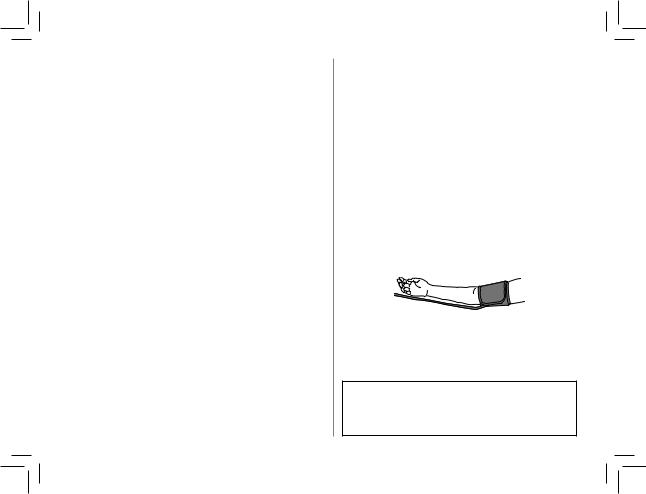
•\ Die Manschette und den Luftschlauch NICHT übermäßig knicken. •\ Den Luftschlauch während der Messung NICHT zusammendrücken
oder knicken. Dies kann durch Unterbrechung des Blutflusses Verletzungen zur Folge haben.
•\ Fassen Sie am Stecker und nicht am Schlauch an, wenn Sie den Kunststoff-Luftschlauchstecker aus dem Schlauchende ziehen.
•\ Verwenden Sie NUR Netzteile, Manschetten, Batterien und andere Zubehörteile, die speziell für dieses Gerät bestimmt sind. Die Verwendung nicht zugelassener Netzteile, Manschetten und Batterien kann das Messgerät beschädigen und/oder zu Gefahren im Zusammenhang mit dem Messgerät führen.
•\ Verwenden Sie NUR die für dieses Messgerät zugelassene Manschette. Die Verwendung anderer Manschetten kann zu falschen Messergebnissen führen.
•\ Aufpumpen auf einen höheren Druck als notwendig kann am Arm, wo die Manschette angelegt ist, zu Blutergüssen führen. HINWEIS: Weitere Informationen finden Sie unter„Wenn Ihr systolischer Druck höher ist als 210 mmHg“ in Abschnitt 13 dieser
Gebrauchsanweisung  .
.
•\ Lesen und befolgen Sie vor der Entsorgung des Gerätes, von Zubehör oder optionalen Teilen die Hinweise unter„Korrekte Entsorgung dieses Produktes“ in Abschnitt 7.
Datenübertragung
•\ Tauschen Sie die Batterien NICHT aus und trennen Sie das Netzteil NICHT, während Ihre Messwerte an Ihr Smartphone oder Tablet übertragen werden. Dies kann zu Fehlfunktionen dieses Messgerätes und zu Fehlern bei der Übertragung Ihrer Blutdruckwerte führen.
Handhabung und Verwendung des Netzteils (optionales Zubehör)
|
•\ Stecken Sie das Netzteil vollständig in die Steckdose. |
|
•\ Ziehen Sie beim Trennen des Netzteils von der Steckdose aus Sicher- |
|
heitsgründen am Stecker. Ziehen Sie NICHT am Kabel des Netzteils. |
|
•\ Korrekter Umgang mit dem Netzteilkabel: |
|
Nicht beschädigen. / Nicht unterbrechen. / Nicht manipulieren. |
|
NICHT einklemmen. / Nicht gewaltsam biegen oder ziehen. / Nicht |
|
verdrehen. |
|
NICHT verwenden, wenn es zu einem Knäuel aufgewickelt ist. |
|
NICHT unter schwere Gegenstände legen. |
|
•\ Befreien Sie das Netzteil von Staub. |
|
•\ Trennen Sie das Netzteil, wenn das Gerät nicht verwendet wird. |
DE3 |
•\ Trennen Sie das Netzteil vor der Reinigung des Messgerätes. |
|
Batterie-Handhabung und -verwendung
•\ Die Batterien NICHT in verkehrter Richtung (Pole auf den falschen Seiten) einsetzen.
•\ Verwenden Sie für dieses Messgerät ausschließlich 4 Alkalioder Manganbatterien vom Typ„AA“. KEINE anderen Batterietypen verwenden. KEINE neuen und gebrauchten Batterien zusammen verwenden. KEINE unterschiedlichen Batteriemarken zusammen verwenden.
•\ Nehmen Sie die Batterien heraus, wenn das Messgerät über einen längeren Zeitraum nicht benutzt wird.
•\ Wenn Batteriesäure in Ihre Augen gelangt, spülen Sie diese sofort mit reichlich klarem Wasser aus. Wenden Sie sich sofort an Ihren Arzt.
•\ Wenn Batteriesäure auf Ihre Haut oder Ihre Kleidung gelangt, spülen Sie diese sofort mit reichlich klarem, lauwarmem Wasser ab. Wenn weiterhin Hautreizung, Verletzung oder Schmerzen bestehen, wenden Sie sich an Ihren Arzt.
•\ Verwenden Sie Batterien NICHT nach dem Ablaufdatum.
•\ Prüfen Sie die Batterien regelmäßig, um sicherzustellen, dass sie sich in einem guten Betriebszustand befinden.
2.3 Allgemeine Vorsichtsmaßnahmen
•\ Wenn Sie die Messung am rechten Arm durchführen, sollte sich der Luftschlauch an der Seite Ihres Ellenbogens befinden. Achten Sie darauf, dass Ihr Arm nicht auf dem Luftschlauch liegt.
•\ Der Blutdruck kann sich zwischen dem rechten und linken Arm unterscheiden. Die gemessenen Blutdruckwerte können daher unterschiedlich sein. Verwenden Sie immer denselben Arm für Messungen. Falls sich die Werte zwischen beiden Armen deutlich unterscheiden, sollten Sie mit Ihrem Arzt absprechen, welchen Arm Sie für Messungen verwenden.
Denken Sie daran, Ihre Blutdruckund Pulsmesswerte für Ihren Arzt aufzuzeichnen. Eine Einzelmessung gibt kein genaues Bild Ihres wahren Blutdrucks.
Im Blutdrucktagebuch können Sie mehrere Messwerte über einen bestimmten Zeitraum erfassen. Unter www.omron-healthcare.com können Sie PDF-Dateien des Tagebuchs herunterladen.

3.\ Fehlermeldungen, Fehlersuche und -behebung
Sollte während der Messung eines der folgenden Probleme auftreten, stellen Sie zunächst sicher, dass sich keine anderen elektrischen Geräte in einem Abstand von weniger als 30 cm zum Messgerät befinden. Ist dies nicht der Fall und das Problem besteht weiterhin, sehen Sie bitte in der folgenden Tabelle nach.
Display/Fehler |
Mögliche Ursache |
Lösung |
|
|
Die Taste [START/STOP] wurde |
Drücken Sie die Taste [START/STOP] erneut, um das Messgerät |
|
|
gedrückt, während die Manschette |
auszuschalten. Stecken Sie den Luftschlauchstecker fest |
|
|
nicht angelegt war. |
ein und legen Sie die Manschette korrekt an. Drücken Sie |
|
|
|
anschließend die Taste [START/STOP]. |
|
erscheint oder die |
Der Luftschlauchstecker wurde nicht |
Stecken Sie den Luftschlauchstecker fest ein. |
|
Manschette pumpt |
korrekt in das Messgerät eingesteckt. |
|
|
nicht auf. |
Die Manschette wurde nicht richtig |
Legen Sie die Manschette korrekt an und messen Sie |
|
|
angelegt. |
erneut. Details dazu finden Sie in Abschnitt 7 dieser |
|
|
|
Gebrauchsanweisung . |
|
|
Die Manschette verliert Luft/hat ein |
Ersetzen Sie die Manschette durch eine neue. Details dazu |
|
|
Leck. |
finden Sie in Abschnitt 14 dieser Gebrauchsanweisung . |
|
wird angezeigt |
Sie haben während der Messung |
Halten Sie still und sprechen Sie während der Messung |
|
oder nach |
gesprochen oder sich bewegt und |
nicht. Wenn„E2“ wiederholt angezeigt wird, pumpen Sie |
|
Aufpumpen der |
die Manschette ist nicht ausreichend |
die Manschette manuell auf, bis der systolische Druck |
|
Manschette kann |
aufgepumpt. |
um 30 bis 40 mmHg über Ihrem letzten Messergebnis |
|
keine Messung |
Da der systolische Blutdruck über |
liegt. Details dazu finden Sie in Abschnitt 13 dieser |
|
durchgeführt |
210 mmHg liegt, kann keine Messung |
Gebrauchsanweisung . |
|
werden. |
durchgeführt werden. |
|
|
|
Die Manschette wurde über |
Die Manschette während der Messung nicht anfassen |
|
erscheint |
dem maximal zulässigen Druck |
bzw. den Luftschlauch nicht knicken. Informationen zum |
|
aufgepumpt. |
manuellen Aufpumpen der Manschette finden Sie in |
||
|
|||
|
|
Abschnitt 13 dieser Gebrauchsanweisung . |
|
|
Sie haben während der Messung |
Halten Sie still und sprechen Sie während der Messung |
|
erscheint |
gesprochen oder sich bewegt. Vibra- |
nicht. |
|
tionen beeinträchtigen die Messleis- |
|
||
|
|
||
|
tung. |
|
DE
DE4
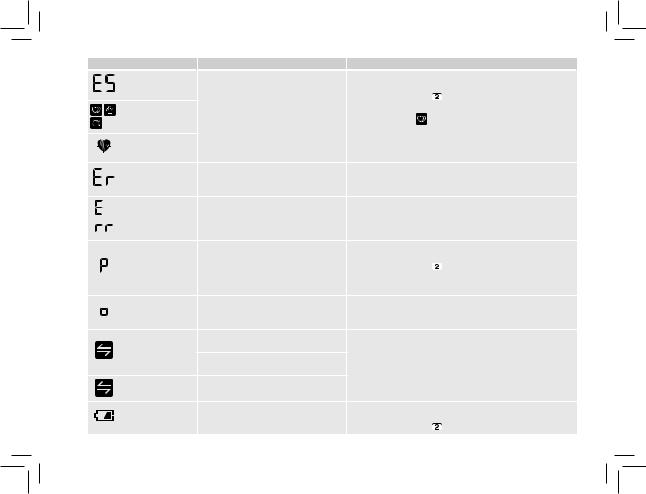
Display/Fehler |
Mögliche Ursache |
Lösung |
|
|
|
erscheint |
Die Pulsfrequenz wird nicht korrekt |
Legen Sie die Manschette korrekt an und messen Sie |
|||
erkannt. |
erneut. Details dazu finden Sie in Abschnitt 7 dieser |
||||
|
|
Gebrauchsanweisung |
. Halten Sie still und setzen Sie sich |
||
/ / erscheint |
|
während der Messung richtig hin. |
|||
|
Wird das Symbol„ |
“ weiterhin angezeigt, sollten Sie sich |
|||
|
|
an Ihren Arzt wenden. |
|
||
blinkt nicht während |
|
|
|
|
|
einer Messung |
|
|
|
|
|
|
Es ist ein Funktionsfehler des |
Drücken Sie die Taste [START/STOP] erneut. Falls„Er“ |
|||
erscheint |
Messgerätes aufgetreten. |
weiterhin angezeigt wird, wenden Sie sich an Ihren OMRON- |
|||
|
|
Einzelhändler oder -Vertreter. |
|||
|
Das Messgerät kann nicht mit einem |
Befolgen Sie die Anweisungen in der App„OMRON connect“. |
|||
erscheint |
Smartphone oder Tablet verbunden |
Wenn das„Err“-Symbol nach Befolgen der App-Anweisungen |
|||
werden oder die Daten können nicht |
weiterhin angezeigt wird, wenden Sie sich an Ihren OMRON- |
||||
|
|||||
|
korrekt übertragen werden. |
Einzelhändler oder -Vertreter. |
|||
|
Das Messgerät wartet auf die |
Informationen zur Kopplung Ihres Messgerätes mit Ihrem |
|||
|
Kopplung mit dem Smartphone oder |
Smartphone oder Tablet finden Sie in Abschnitt 5 dieser |
|||
blinkt |
Tablet. |
Gebrauchsanweisung |
. Sie können auch die Taste |
||
|
|
[START/STOP] drücken, um die Kopplung abzubrechen |
|||
|
|
und Ihr Messgerät auszuschalten. |
|||
|
Das Messgerät ist bereit für die |
Öffnen Sie die App„OMRON connect“, um Ihre Messwerte |
|||
blinkt |
Übertragung Ihrer Messwerte auf das |
zu übertragen. |
|
|
|
|
Smartphone oder Tablet. |
|
|
|
|
|
Es werden maximal 48 Messwerte |
Übertragen Sie Ihre Messwerte in die App„OMRON |
|||
blinkt |
übertragen. |
connect“, um sie dort zu speichern. Anschließend wird das |
|||
Datum und Uhrzeit wurden nicht |
Fehlersymbol nicht mehr angezeigt. |
||||
|
|||||
|
eingestellt. |
|
|
|
|
erscheint |
Es befinden sich 60 Messwerte zur |
|
|
|
|
Übertragung in Ihrem Speicher. |
|
|
|
||
|
|
|
|
||
|
Der Ladestand der Batterien ist niedrig. Es wird empfohlen, alle 4 Batterien gleichzeitig durch neue |
||||
blinkt |
|
zu ersetzen. Details dazu finden Sie in Abschnitt 4 dieser |
|||
DE5 |
|
Gebrauchsanweisung . |
|||

Display/Fehler |
Mögliche Ursache |
Lösung |
|
|
wird angezeigt |
Die Batterien sind leer. |
Ersetzen Sie umgehend alle 4 Batterien durch |
|
|
oder das |
|
neue. Details dazu finden Sie in Abschnitt 4 dieser |
|
|
Messgerät schaltet |
|
Gebrauchsanweisung . |
|
|
sich während |
|
|
|
|
einer Messung |
|
|
|
|
unerwartet aus |
|
|
|
|
Auf dem Display des |
Die Batteriepole sind nicht richtig |
Überprüfen Sie, ob die Batterien richtig eingesetzt |
|
|
Messgerätes wird nichts |
|
|||
angezeigt. |
ausgerichtet. |
sind. Details dazu finden Sie in Abschnitt 4 dieser |
|
|
|
|
Gebrauchsanweisung . |
|
|
Die Messwerte erscheinen |
Der Blutdruck schwankt ständig. Viele Faktoren einschließlich Stress, Tageszeit und Lage |
|
||
der Manschette können den Blutdruck beeinflussen. Lesen Sie dazu Abschnitt 2 dieser |
DE |
|||
zu hoch oder zu niedrig. |
||||
Gebrauchsanweisung . |
|
|||
Sonstige Kommunikations Befolgen Sie die auf dem Smartphone oder Tablet angezeigten Anweisungen oder rufen Sie die probleme. „Hilfe“sektion in der App „OMRON connect“ auf. Falls das Problem weiterhin besteht, wenden Sie
sich an Ihren OMRON-Einzelhändler oder -Vertreter.
Drücken Sie die Taste [START/STOP], um das Messgerät auszuschalten. Drücken Sie die Taste dann erneut, um eine Messung durchzuführen. Wenn das Problem weiterhin auftritt, entnehmen
Sonstige Probleme. Sie alle Batterien und warten Sie 30 Sekunden. Setzen Sie anschließend die Batterien wieder ein. Falls das Problem weiterhin besteht, wenden Sie sich an Ihren OMRON-Einzelhändler oder -Vertreter.
4.\ Eingeschränkte Garantie
Vielen Dank für den Kauf eines OMRON-Produkts. Diese Produkt wurde aus hochwertigen Materialien und mit großer Sorgfalt hergestellt. Es wurde |
|
||||
entwickelt, um Sie voll zufrieden zu stellen, insofern es korrekt betrieben und gewartet wird wie in der Gebrauchsanweisung beschrieben. |
|
||||
OMRON übernimmt für dieses Produkt eine Garantie für die Zeitdauer von 3 Jahren nach dem Kauf. OMRON garantiert die korrekte Konstruktion, |
|
||||
Fertigung und Materialien für dieses Produkt. Während dieser Garantiedauer übernimmt OMRON, ohne Gebühren für Arbeiten oder Teile zu |
|
||||
erheben, die Reparatur bzw. den Austausch defekter Produkte oder defekter Teile. |
|
||||
Folgende Fälle werden nicht durch die Garantie abgedeckt: |
|
||||
A.\Transportkosten |
und -risiken. |
|
|||
B.\Kosten für Reparaturen bzw. Defekte, die durch Reparaturen durch unbefugte Personen entstanden. |
|
||||
C.\Regelmäßige |
Überprüfung und Wartung. |
|
|||
D.\Ausfall |
oder Verschleiß optionaler Teile oder anderen Zubehörs außer dem Hauptgerät selbst, außer oben ausdrücklich garantiert. |
DE6 |
|||
E.\ Kosten, |
die durch eine Anspruchsverweigerung entstehen (hier werden Gebühren erhoben). |
||||

F.\ Jegliche Schäden und Verletzungen, die versehentlich oder durch Missbrauch entstehen. G.\Kalibrierungsdienste sind nicht in der Garantie enthalten.
H.\Für optionale Teile gilt eine Garantie von einem (1) Jahr nach dem Kauf. Zu den optionalen Teilen gehören unter anderem die folgenden Teile: Manschette und Manschettenschlauch.
Falls Garantieleistungen in Anspruch genommen werden müssen, wenden Sie sich an den Händler, bei dem das Produkt gekauft wurde, oder einen autorisierten OMRON-Vertreter. Die Adresse finden Sie auf der Produktverpackung/den Broschüren oder erhalten Sie bei Ihrem Fachhändler. Falls Sie Schwierigkeiten haben sollten, den OMRON-Kundendienst zu finden, wenden Sie sich für weitere Informationen an uns: www.omron-healthcare.com
Eine Reparatur oder ein Austausch im Rahmen der Garantie führt nicht zu einer Verlängerung oder Erneuerung der Garantiedauer.
Die Garantie wird nur gewährt, wenn das komplette Produkt zusammen mit der Originalrechnung/dem Kassenbeleg für den Kunden ausgestellt durch den Händler zurückgesandt wird.
5.\ Wartung
5.1 Wartung
Damit das Messgerät nicht beschädigt wird, bitte Folgendes beachten:
Veränderungen oder Modifikationen, die vom Hersteller nicht genehmigt sind, führen zum Erlöschen der Benutzergarantie.

 Achtung
Achtung
Das Messgerät und andere Komponenten NICHT zerlegen oder versuchen, diese selbst zu reparieren. Dies könnte falsche Messwerte hervorrufen.\
5.2 Lagerung
•\ Bewahren Sie Ihr Messgerät in der Aufbewahrungstasche auf.
1.\Trennen Sie die Manschette vom Messgerät.

 Achtung
Achtung
Fassen Sie am Stecker und nicht am Schlauch an, wenn Sie den Kunststoff-Luftschlauchstecker aus dem Schlauchende ziehen.\
2.\Legen Sie den Luftschlauch vorsichtig gefaltet in die Manschette. Hinweis: Biegen oder knicken Sie den Luftschlauch nicht übermäßig. 3.\Legen Sie Ihr Messgerät und die zugehörigen Komponenten in die Aufbewahrungstasche.
•\ Bewahren Sie das Messgerät und die Komponenten an einem sauberen und sicheren Ort auf. •\ Beachten Sie weiterhin Folgendes zur Lagerung des Messgerätes und der Komponenten:
•\Das Messgerät und die Komponenten dürfen nicht in nassem Zustand gelagert werden.
•\Orte, die extremen Temperaturen, Luftfeuchtigkeit, direktem Sonnenlicht, Staub oder ätzenden Dämpfen, wie etwa Bleichmitteln, ausgesetzt sind, sind als Aufbewahrungsorte nicht geeignet.
•\Orte, die Erschütterungen oder Stößen ausgesetzt sind, sind als Aufbewahrungsorte nicht geeignet.
DE7

5.3 Reinigung
•\ Keine Scheuermittel oder flüchtigen Reinigungsmittel verwenden.
•\ Reinigen Sie das Messgerät und die Manschette mit einem weichen trockenen Tuch oder einem weichen, mit mildem (neutralem) Reinigungsmittel befeuchteten Tuch und wischen Sie anschließend mit einem trockenen Tuch nach.
•\ Messgerät und Manschette oder andere Komponenten dürfen nicht mit Wasser abgewaschen oder in Wasser getaucht werden. •\ Zum Reinigen des Messgerätes und der Manschette kein Benzin, Verdünner oder ähnliche Lösungsmittel verwenden.
5.4 Kalibrierung und Wartung
•\ Die Genauigkeit dieses Blutdruckmessgerätes wurde sorgfältig geprüft und im Hinblick auf eine lange nutzbare Lebensdauer entwickelt.
•\ Es wird im Allgemeinen empfohlen, bei dem Messgerät alle zwei Jahre eine Messtechnische Kontrolle durchführen zu lassen, um die korrekte Funktion und die Genauigkeit des Gerätes sicherzustellen. Wenden Sie sich an Ihren autorisierten OMRON-Fachhändler oder OMRONKundendienst, dessen Adresse auf der Verpackung oder den beigelegten Broschüren angegeben ist.
6.\ Technische Daten
Produktbeschreibung |
Automatisches Oberarm-Blutdruckmessgerät |
|
|
Produktkategorie |
Elektronische Blutdruckmessgeräte |
|
|
Modell (Artikelnummer) |
M4 Intelli IT (HEM-7155T-EBK) |
Display |
Digitales LCD-Display |
|
X4 Smart (HEM-7155T-ESL) |
|
|
Manschettendruckbereich |
0 bis 299 mmHg |
Messbereich für Puls |
40 bis 180 Schläge/Min. |
Messbereich für Blutdruckmessung |
SYS: 60 bis 260 mmHg / DIA: 40 bis 215 mmHg |
|
|
Genauigkeit |
Druck: ± 3 mmHg / Puls: ± 5 % des Displaywerts |
|
|
Aufpumpen |
Automatisch durch die |
Luftablass |
Automatisches Luftablassventil |
|
elektrische Pumpe |
|
|
Messmethode |
Oszillometrische Methode |
Übertragungsmethode |
Bluetooth® Low Energy |
Drahtlose Kommunikation |
Frequenzbereich: 2,4 GHz (2.400–2.483,5 MHz) / Modulation: GFSK |
||
|
Effektive Strahlungsleistung: < 20 dBm |
|
|
Betriebsart |
Dauerbetrieb |
|
|
IP-Klassifizierung |
Messgerät: IP20 / Optionales Netzteil: IP21 |
|
|
Nenngrößen |
6 VDC 4,0 W |
Anwendungsteil |
Typ BF (Manschette) |
Stromquelle |
4„AA“-Batterien 1,5 V oder optionales Netzteil (Eingangsleistung 100–240 VAC, 50–60 Hz, |
||
|
0,12–0,065 A) |
|
|
Batterielebensdauer |
Ca. 1.000 Messungen (mit neuen Alkalibatterien) |
|
|
Nutzungsdauer (Betriebszeit) |
Messgerät: 5 Jahre / Manschette: 5 Jahre / Optionales Netzteil: 5 Jahre |
||
DE
DE8

Betriebsbedingungen |
+10 bis +40 °C / 15 bis 90 % relative Luftfeuchtigkeit (ohne Kondensation) / |
|
800 bis 1.060 hPa |
Lagerungs-/ |
-20 bis +60 °C / 10 bis 90 % relative Luftfeuchtigkeit (ohne Kondensation) |
Transportbedingungen |
|
Inhalt |
Blutdruckmessgerät, Intelli Wrap Manschette (HEM-FL31), 4 Batterien vom Typ„AA“, |
|
Aufbewahrungstasche, Gebrauchsanweisung und , Einrichtungsanleitung |
Schutz vor Stromschlägen |
ME-Gerät mit interner Versorgung (bei reinem Batteriebetrieb) |
|
Gerät der Klasse II ME (optionales Netzteil) |
Gewicht |
Messgerät: ca. 340 g (ohne Batterien) / Manschette: ca. 163 g |
Abmessungen (ungefähr) |
Messgerät: 105 mm (B) × 85 mm (H) × 152 mm (L) |
|
Manschette: 145 mm × 532 mm (Luftschlauch: 750 mm) |
Speicher |
Maximal 60 Messwerte pro Benutzer |
Hinweis
•\ Änderung dieser technischen Daten ohne Ankündigung vorbehalten.
•\ Dieses Messgerät wurde gemäß den Anforderungen der ISO 81060-2:2013 klinisch getestet. In der klinischen Validierungsstudie wurde K5 zur Messung des diastolischen Blutdrucks bei 85 Probanden verwendet.
•\ Dieses Gerät wurde für den Einsatz bei Schwangeren und Präeklampsie-Patientinnen gemäß dem modifizierten Protokoll der Europäischen Gesellschaft für Hypertonie* validiert.
•\ Dieses Gerät wurde für den Einsatz bei Diabetikern (Typ II) validiert**.
•\ Die IP-Klassifizierung gibt den Schutzgrad von Gehäusen gemäß IEC 60529 an. Dieses Messgerät und das optionale Netzteil sind gegenüber festen Fremdkörpern mit einem Durchmesser ab 12,5 mm – etwa einem Finger – geschützt. Das optionale Netzteil ist gegen vertikal fallende Wassertropfen geschützt, die bei Normalbetrieb Probleme verursachen können.
*Topouchian J et al. Vascular Health and Risk Management 2018:14 189–197
**Chahine M.N. et al. Medical Devices: Evidence and Research 2018:11 11–20
Hinweise auf Störungen der drahtlosen Kommunikation
Dieses Produkt arbeitet im lizenzfreien ISM-Band bei 2,4 GHz. Wird dieses Produkt in der Nähe anderer drahtloser Geräte wie Mikrowellengeräte und WLAN-Geräte verwendet, die das gleiche Frequenzband wie dieses Produkt verwenden, können Störungen auftreten. Beenden Sie bei auftretenden Störungen den Betrieb der anderen Geräte oder verwenden Sie dieses Produkt nicht in der Nähe anderer drahtloser Geräte.
DE9
